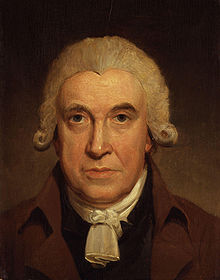ജെയിംസ് വാട്ട്
ഒരു സ്കോട്ടിഷ് മെക്കാനിക്കൽ എഞ്ചിനിയറായിരുന്നു ജെയിംസ് വാട്ട്എഫ്.ആർ.എസ്., എഫ്.ആർ.എസ്.ഇ. (1736 ജനുവരി 19 – 1819 ഓഗസ്റ്റ് 25)[1].ഇദ്ദേഹം ആവി യന്ത്രത്തിൽ വരുത്തിയ മെച്ചപ്പെടുത്തലുകളാണ് വ്യവസായ വിപ്ലവം മൂലമുണ്ടായ മാറ്റങ്ങൾക്ക് അടിസ്ഥാനമിട്ടത്.
ജെയിംസ് വാട്ട് | |
|---|---|
 | |
| ജനനം | ജനുവരി 19, 1736 |
| മരണം | 1819 ഓഗസ്റ്റ് 25 [1] |
ഗ്ലാസ്ഗോ സർവ്വകലാശാലയിൽ ഉപകരണനിർമാതാവായി ജോലിചെയ്യുമ്പോൾ വാട്ട് ആവിയന്ത്രങ്ങളുടെ സാങ്കേതികവിദ്യയിൽ ആകൃഷ്ടനായി. അക്കാലത്ത് നിലവിലുണ്ടായിരുന്ന ആവിയന്ത്രങ്ങൾ ഇടയ്ക്കിടെ സിലിണ്ടർ തണുക്കുകയും വീണ്ടും ചൂടാക്കേണ്ടിവരുകയും ചെയ്യുന്ന തരത്തിലുള്ള സാങ്കേതികവിദ്യയാണ് ഉപയോഗിച്ചിരുന്നത്. ഇത് ധാരാളം ഊർജ്ജം നഷ്ടപ്പെടാനിടയാക്കുന്നുണ്ട് എന്ന് വാട്ട് മനസ്സിലാക്കി. ഒരു പ്രത്യേക കണ്ടൻസർ ഉപയോഗിക്കുന്നതിലൂടെ യന്ത്രങ്ങളുടെ ശക്തി വർദ്ധിപ്പിക്കാനും ഊർജ്ജനഷ്ടം കുറയ്ക്കാനുമുതകുന്ന ഒരു സാങ്കേതിക സംവിധാനം ഇദ്ദേഹം അവതരിപ്പിച്ചു. ഇതിലൂടെ ആവിയന്ത്രങ്ങളുടെ ചിലവിനനുപാതമായി ലഭിക്കുന്ന പ്രയോജനം വളരെ വർദ്ധിക്കുകയുണ്ടായി. അന്തിമമായി ഇദ്ദേഹം ആവിയന്ത്രം ചക്രം തിരിക്കാവുന്ന രീതിയിൽ ഉപയോഗിക്കാനുള്ള സംവിധാനവും വികസിപ്പിച്ചു. വെള്ളം പമ്പ് ചെയ്യുക എന്നതായിരുന്നു അതുവരെ ആവിയന്ത്രത്തിന്റെ പ്രധാന ഉപയോഗം . ഈ കണ്ടുപിടിത്തത്തോടെ ആവിയന്ത്രം ധാരാളം മേഖലകളിൽ ഉപയോഗിക്കാനുള്ള സാദ്ധ്യത നിലവിൽ വന്നു.
ഈ കണ്ടുപിടിത്തം വ്യാവസായികാടിസ്ഥാനത്തിൽ ഉപയോഗിക്കാൻ വാട്ട് ശ്രമിക്കുകയുണ്ടായി. 1775-ൽ മാത്യു ബോൾട്ടണുമായി ചേർന്ന് ഒരു സ്ഥാപനം രൂപീകരിക്കുന്നതുവരെ ഇദ്ദേഹം കടുത്ത സാമ്പത്തികബുദ്ധിമുട്ടുകളായിരുന്നു നേരിട്ടത്. പുതിയ കമ്പനി (ബൗൾട്ടൺ ആൻഡ് വാട്ട്) സാമ്പത്തികമായി നേട്ടമുണ്ടാക്കുകയും വാട്ട് വലിയ ധനികനാവുകയും ചെയ്തു. വാട്ട് പല പുതിയ കണ്ടുപിടിത്തങ്ങളും നടത്തിയെങ്കിലും ഒന്നും ആവിയന്ത്രത്തോളം വിജയം കൈവരിച്ചില്ല. 1819-ൽ 83-ആം വയസ്സിലാണ് ഇദ്ദേഹം മരിച്ചത്. മനുഷ്യചരിത്രത്തിൽ ഏറ്റവും സ്വാധീനം ചെലുത്തിയ വ്യക്തികളിലൊരാളാണ് ഇദ്ദേഹം എന്ന് കണക്കാക്കപ്പെടുന്നു.[2]
കുതിരശക്തി എന്ന ആശയം ഇദ്ദേഹത്തിന്റെ സൃഷ്ടിയാണ്.[3] ശക്തിയുടെ എസ്.ഐ. യൂണിറ്റായ വാട്ട് ഇദ്ദേഹത്തിന്റെ പേരിലാണ് അറിയപ്പെടുന്നത്.
ജീവിതരേഖ
തിരുത്തുക1736 ജനുവരി 19-ന് സ്കോട്ട്ലണ്ടിലെ ഫിർത്ത് ഓഫ് ക്ലൈഡിലെ ഗ്രീനോക്ക് എന്ന തുറമുഖ പട്ടണത്തിൽ ജനിച്ചു. 1819 ഓഗസ്റ്റ് 25-ന് ഇംഗ്ലണ്ടിലെ സ്റ്റഫോർഡ്ഷയറിലെ ഹാൻഡ്സ്വർത്തിൽവച്ച് അന്തരിച്ചു.
ഇദ്ദേഹത്തിന്റെ ബഹുമാനാർത്ഥമാണ് പവറിന്റെ ഏകകത്തിന് വാട്ട് എന്ന് പേര് നൽകിയിരിക്കുന്നത്.
അവലംബം
തിരുത്തുക- ↑ 1.0 1.1 Although a number of otherwise reputable sources give his date of death as 19 August 1819, all contemporary accounts report him dying on 25 August and being buried on 2 September. The earliest known instance of the 19 August date appearing in the literature is in a book published in 1901.
- ↑ Hart, Michael H. (2000). The 100: A Ranking of the Most Influential Persons in History. New York: Citadel. ISBN 0-89104-175-3.
{{cite book}}: Invalid|ref=harv(help) - ↑ Lira, Carl (2001). "Biography of James Watt". egr.msu.edu. Retrieved 2010 July 5.
{{cite web}}: Check date values in:|accessdate=(help)
ഗ്രന്ഥസൂചിക
തിരുത്തുക- "Some Unpublished Letters of James Watt" in Journal of Institution of Mechanical Engineers (London, 1915).
- Carnegie, Andrew, James Watt University Press of the Pacific (2001) (Reprinted from the 1913 ed.), ISBN 0-89875-578-6.
- Dickinson, H. W. (1935). James Watt: Craftsman and Engineer. Cambridge University Press.
- Dickinson, H. W. and Hugh Pembroke Vowles James Watt and the Industrial Revolution (published in 1943, new edition 1948 and reprinted in 1949. Also published in Spanish and Portuguese (1944) by the British Council)
- Hills, Rev. Dr. Richard L., James Watt, Vol 1, His time in Scotland, 1736-1774 (2002); Vol 2, The years of toil, 1775-1785; Vol 3 Triumph through adversity 1785-1819. Landmark Publishing Ltd, ISBN 1-84306-045-0.
- Hulse David K. (1999). The early development of the steam engine. Leamington Spa, UK: TEE Publishing. pp. 127–152. ISBN 1-85761-107-1.
- Hulse David K. (2001). The development of rotary motion by steam power. Leamington, UK: TEE Publishing Ltd. ISBN 1-85761-119-5.
- Marsden, Ben. Watt's Perfect Engine Columbia University Press (New York, 2002) ISBN 0-231-13172-0.
- Marshall, Thomas H. (1925), James Watt, Chapter 3: Mathematical Instrument Maker Archived 2005-12-21 at the Wayback Machine., from Steam Engine Library of University of Rochester Department of History.
- Marshall, Thomas H. (1925) James Watt Archived 2005-12-21 at the Wayback Machine., University of Rochester Department of History.
- Muirhead, James Patrick (1854). Origin and Progress of the Mechanical Inventions of James Watt. London: John Murray.
- Muirhead, James Patrick (1858). The Life of James Watt. London: John Murray.
- Roll, Erich (1930). An Early Experiment in Industrial Organisation : being a History of the Firm of Boulton & Watt. 1775-1805. Longmans, Green and Co.
- Smiles, Samuel, Lives of the Engineers, (London, 1861–62, new edition, five volumes, 1905).
- ബന്ധമുള്ള വിഷയങ്ങൾ
- Schofield, Robert E. (1963). The Lunar Society, A Social History of Provincial Science and Industry in Eighteenth Century England. Clarendon Press.
- Uglow, Jenny (2002). The Lunar Men. London: Farrar, Straus and Giroux.
പുറത്തേയ്ക്കുള്ള കണ്ണികൾ
തിരുത്തുക- James Watt by Andrew Carnegie (1905)
- James Watt by Thomas H. Marshall (1925) Archived 2005-12-21 at the Wayback Machine.
- Archives of Soho Archived 2011-10-31 at the Wayback Machine. at Birmingham Central Library.
- BBC History: James Watt
- Revolutionary Players website Archived 2006-03-08 at the Wayback Machine.
- Cornwall Record Office Boulton and Watt letters Archived 2017-11-06 at the Wayback Machine.
- Significant Scots - James Watt
- "Chapter 8: The Record of the Steam Engine". www.history.rochester.edu. Archived from the original on 2009-07-08. Retrieved 2009-07-06.
|PLACE OF BIRTH=Greenock, Scotland
|DATE OF DEATH=1819 ഓഗസ്റ്റ് 25
|PLACE OF DEATH=Handsworth, Staffordshire, England
}}